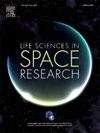The microwave electromagnetic background as measured onboard the International Space Station
IF 2.8
3区 生物学
Q2 ASTRONOMY & ASTROPHYSICS
引用次数: 0
Abstract
This paper presents an attempt to experimentally evaluate the actual radiofrequency exposure levels onboard the International Space Station in terms of absorbed energy (power) density, which is essential for the confirmation of manned space flight safety. The measurements were made with the use of compact stand-alone electromagnetic dosimeters, capable for recording the absorbed energy (power) density in the frequency band 0.8–8.0 GHz once per minute. As a result of experimental data analysis for two representative locations at the MLM module of the ISS, it is possible to establish that the absorbed energy (power) densities can reach the following levels: 0.7 nW/cm2 on average per day with maximal possible value of 119.8 nW/cm2 in the Crew cabin; and 1.4 nW/cm2 on average per day with maximal possible value of 207.8 nW/cm2 at Central post. Though the maximal exposure levels recommended for the ISS electromagnetic hardware in the similar frequency band aren't exceeded so far, the existing recommendations for the ISS electromagnetic hardware with frequencies above 8.0 GHz makes us believe such equipment can pose an excessive radiofrequency exposure in some of the locations at ISS, so the further experimental electromagnetic measurements are still necessary in the extended frequency band.
在国际空间站上测量的微波电磁背景
本文尝试从吸收能量(功率)密度的角度对国际空间站上的实际射频暴露水平进行实验评估,这对确认载人航天飞行的安全性至关重要。测量使用紧凑的独立电磁剂量计,能够记录每分钟一次0.8-8.0 GHz频段的吸收能量(功率)密度。通过对国际空间站MLM模块两个代表性位置的实验数据分析,可以确定吸收的能量(功率)密度可以达到以下水平:平均每天0.7 nW/cm2,乘员舱的最大可能值为119.8 nW/cm2;平均每日辐射量为1.4西北瓦/平方厘米,而中环站的最大值为207.8西北瓦/平方厘米。虽然目前还没有超过国际空间站电磁硬件在类似频段的最大推荐暴露水平,但是根据现有的国际空间站电磁硬件在8.0 GHz以上的推荐频率,我们认为这类设备在国际空间站的某些位置可能会造成过度的射频暴露,因此在扩展的频段内,仍有必要进行进一步的实验电磁测量。
本文章由计算机程序翻译,如有差异,请以英文原文为准。
求助全文
约1分钟内获得全文
求助全文
来源期刊

Life Sciences in Space Research
Agricultural and Biological Sciences-Agricultural and Biological Sciences (miscellaneous)
CiteScore
5.30
自引率
8.00%
发文量
69
期刊介绍:
Life Sciences in Space Research publishes high quality original research and review articles in areas previously covered by the Life Sciences section of COSPAR''s other society journal Advances in Space Research.
Life Sciences in Space Research features an editorial team of top scientists in the space radiation field and guarantees a fast turnaround time from submission to editorial decision.
 求助内容:
求助内容: 应助结果提醒方式:
应助结果提醒方式:


